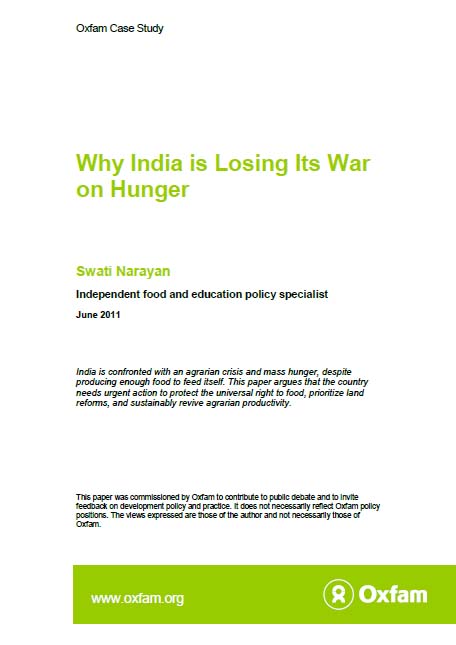 The paper argues that the country needs urgent action to protect the universal right to food, prioritize land reforms, and sustainably revive agrarian productivity.
The paper argues that the country needs urgent action to protect the universal right to food, prioritize land reforms, and sustainably revive agrarian productivity.
India is home to a quarter of the world’s hungry people. Since the green revolution, the country has produced enough to feed itself, but it has not yet been able to wipe out mass hunger, which haunts the landscape of the countryside and lurks in the narrow alleys of urban slums.
Currently, 40 per cent of the population is malnourished – a decrease of only 10 per cent over the past three decades. Poor families, who spend more than 60 per cent of their incomes on food, are increasingly struggling to stretch their meagre household budgets. Unfortunately, small farmers have not benefited from high retail prices either, as they usually receive far less for their produce. In fact in the past 15 years, in an unprecedented wave, a quarter of a million farmers crippled by debt have chosen to commit suicide.
Clearly, the country is in the midst of both an agrarian crisis and a nutrition crisis, the causes being -
- Lopsided development - Historically, for generations socio-economic advancement has bypassed the majority of the population. Even in the recent surge towards modernity, three systemic trends of impoverishment are evident: jobless growth, diminishing agrarian returns, and social exclusion.
- Jobless growth - Since the 1980s, average family incomes have increased rapidly. However, the educated elite have cornered most of these gains. Indian factories have also failed to create sufficient low-skilled, labour-intensive jobs, in a country where one-third of the population is illiterate. So, with few alternatives in sight, more than half of the country’s working-age adults toil in the fields. However, they produce only one-fifth of India’s GDP and hunger often stalks rural homes.
- Agrarian returns are diminishing - Two-thirds of India’s poor people live in this rural landscape where access to land is all important. But even after decades of failed land reforms, 41 per cent of rural households are effectively landless. Furthermore, three-quarters of farm owners possess only subsistence plots of less than one hectare, from which they are barely able to eke out a living. Worse still, since the 1990s, economic policies have sidelined agriculture, which has slipped into a deep crisis. While the government’s agrarian investments have shrunk, the number of indebted smallholder farmers has doubled. With these odds stacked against them, 40 per cent of farmers across India admitted in a 2005 survey that, if given a choice, they would prefer to quit farming.
- Social exclusion - Caste, which has regimented occupational choices in India for generations, also plays a role in aggravating poverty and hunger. For decades too, large dams, steel mills, and other ‘temples of modern India’ have displaced millions of indigenous tribal (scheduled tribes), who are among the most impoverished of India’s people, from their traditional homes. The traditional family structure also breeds subtle forms of social exclusion.
In the midst of this overwhelming national hunger crisis, many progressive strands of change have emerged, from both Indian civil and political society. In the past decade, India has made some headway in the battle against inter-generational hunger. But the opportunity to redistribute the gains of sustained economic growth has been lost. The main culprit is entrenched inequality in the modes of production and distribution of food.
India’s democracy has proved to be both its strength and its weakness. While the progressive Right to Food campaign has had sporadic successes, a decade after its formation the tragedy of excess food grains rotting in granaries has been repeated.
At this current sluggish pace of change, India will halve hunger only by 2083 – nearly 70 years after the MDG deadline. To accelerate momentum, effective implementation of the National Food Security Bill will be key. However, a real game changer would need a renewed emphasis on land reform and a sustainable revival of agrarian productivity.
Download the report here -